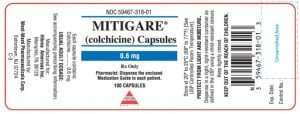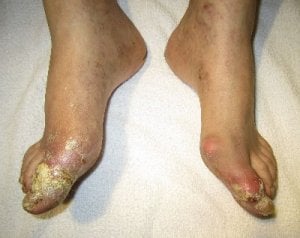Gout Dictionary
A good gout dictionary can make all the difference when you are trying to understand gout. It really helps you understand the scientific gout information that experts produce for us.
This gout glossary explains terminology commonly associated with gout and related diseases. I have listed common gout terms in alphabetic order.
| Abbreviation/Term | Definition |
|---|---|
| antihyperuricemic | Something, normally a drug, that lowers uric acid levels in the blood. |
| arthrocentesis | Arthrocentesis, a procedure also known as aspiration, involves drawing fluid from the joint. This fluid is then analyzed to confirm the presence of crystals. |
| arthropathy | Joint disease. A general term for any type of joint disease, including all forms of arthritis such as gout and pseudogout. |
| Case-crossover | An investigation where different treatments (including placebo or no treatment) are compared in the same person over different time periods. I.e. they crossover from one treatment to another. |
| CPDD – Calcium Pyrophosphate Deposition Disease | Similar symptoms to gout, but totally different cause. Some gout pain relievers may help, but uric acid lowering treatments are useless (unless you have gout as well). Similarities lead to the common name of pseudogout (AKA pseudo gout, sudogout and sudo gout) |
| CT – Computed Tomography | Also called CT scan and CAT scan, this process combines focused x-rays with computer imaging techniques to build a 3D image. For gout sufferers, this process can help measure the extent of tophi. |
| Hydrochlorothiazide | A diuretic, or water pill, commonly used to treat high blood pressure. This can increase the risk of gout attacks by increasing the concentration of uric acid in the blood. Gout patients should ask their doctor to prescribe alternative blood pressure reducing medication. |
| hydroxyapatite arthropathy | Deposits of hydroxyapatite crystals. This is a complex disease involving joint damage. There is doubt whether the crystals are a result or a cause of joint damage. Common in the shoulder, hence it’s common name of Milwaukee Shoulder Syndrome. It has been found in several other joints and is now often referred to as Milwaukee Syndrome. |
| immunosuppressant | Something that suppresses the immune system. As gout pain is an immune system response, these suppressants might be useful, however, they risk reducing the body’s ability to fight other diseases. |
| Indocin – brand of indomethacin | An anti-inflammatory drug (NSAID), widely prescribed for gout pain relief. |
| intraosseous | Within the bone. Included in this gout dictionary because tophi can grow into bones, causing bone erosion and serious joint damage. |
| leucocyte | White blood cell. |
| MTX – methotrexate | A drug commonly used to reduce inflammation for rheumatic diseases such as rheumatoid arthritis and psoriatic arthritis. It can reduce the body’s ability to fight disease and must be taken with careful medical supervision – normally only once a week on the same day. |
| monoarthritis | Arthritis, e.g. gouty arthritis, that affects a single join at any one time. Contrast with oligoarthritis and polyarthritis. |
| oligoarthritis | Arthritis, e.g. gouty arthritis that affects four joints or fewer at the same time. Contrast with monoarthritis and polyarthritis. |
| phagocyte | A white blood cell that ingests foreign particles in the blood. This is good for killing bacteria, but uric acid crystals cannot be killed, so inflammation continues until the crystals are completely engulfed. |
| phagocytosis | The process of ingesting uric acid crystals (and other foreign particles such as bacteria) by phagocytes (see above). |
| polyarthritis | Arthritis, e.g. gouty arthritis that affects five joints or more at the same time. Contrast with monoarthritis and oligoarthritis. |
| polymorphonuclear | Lobed or segmented nucleus, often used to describe a white blood cell that can engulf uric acid crystals and other foreign particles (see phagocyte above). |
| prospective study | Confusingly, prospective usually means something expected or likely to happen in future. However, in medical terms, a prospective study is more related to prospecting, as in prospecting for gold. Specifically, a prospective study starts with a group of healthy people, and studies aspects of their lives over time to look for correlations with health conditions. The resulting statistics do not prove causal links, but give pointers for investigators to look more closely at specific factors relating to health conditions. |
| RCT – Randomized controlled trial | Used to test different forms of treatment (or one treatment against no treatment). Participants are randomly allocated to different groups. Groups are treated exactly the same except for the treatments being tested. Where possible, participants do not know which treatment group they are in (double blinding). |
| refractory | Resistant to control – often used to describe medical conditions that do not respond to conventional treatments. |
| renal | Related to the kidneys and their function. |
| sUr – serum urate concentrations | The amount of uric acid in your blood. There are 2 common scales – mmol/L and mg/dL, with a third scale, μmol/L used in some countries. You can easily convert between uric acid scales. |
| tophaceous | As in tophaceous gout, an advanced stage of gouty arthritis where deposits of uric acid crystals (tophi) are visible under the skin. |
| U&E Blood Test | The U&E blood test, often called UE test, is a standard medical test for Urea and Electrolytes. It is not a gout specific test, and is therefore beyond the scope of this website. You must discuss results with your doctor, as results must be viewed in the context of your general health and medical history. |
Next Gout Dictionary Steps
Have you seen any gout related terms that you don’t understand? Please discuss them in the Gout Forum.
To learn more about gout related issues see the rest of this gouty arthritis information section.
Please give your feedback
Did this page help you? If yes, please consider a small donation. Your donations help keep GoutPal's gout support services free for everyone.
If not, please tell me how I can improve it to help you more.
- YouTube
- The gout forums.








